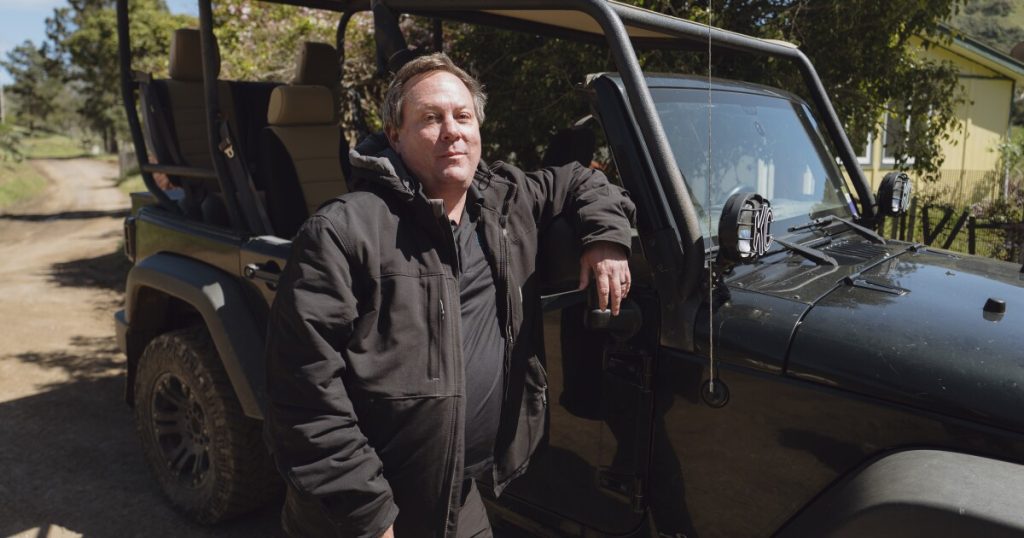Lance Ware has been in the internet business since the early days of dial-up, but he still has trouble getting decent internet service on Catalina Island.
It wasn’t until the pandemic that he truly learned the extent of its connection issues. Ware had tried to isolate in paradise, bringing his two daughters along to remote-learn while he worked from his home office. But he quickly realized that wasn’t going to be possible with the island’s limited internet service.
“They couldn’t stream, they couldn’t get online, they couldn’t even get audio,” Ware said. “And then I realized I’m basically stealing bandwidth from the kids here.”

The canyons of Catalina Island
DANIEL SLIM/AFP via Getty Images
/
AFP
)
Limited infrastructure
Located just an hour off the coast, Catalina Island is among the top destinations for a weekend getaway or school field trip from L.A.
Hundreds of thousands of visitors take the ferry each year for scuba diving and zip lining, or to simply relax on the beach and enjoy the wildlife.
But for 4,000 or so residents, the island lifestyle comes at a cost: erratic internet connection.
There’s no residential access to fiber on the largely rural island. Larger companies like AT&T and Spectrum don’t provide internet service here because it’s too expensive.

At the high peak of the mountain, the lone AT&T tower satellite comes into view.
With limited infrastructure, some island residents get Wi-Fi from a small local provider, while others use their phones as hotspots, but everyone is competing for the same bandwidth.

The economy of Catalina Island is supported primarily through tourism
When you factor in difficult terrain and often stormy weather, getting online can be a nightmare — especially for those who live outside of the island’s two towns.
Losing critical revenue
The problem affects every aspect of life on the island.
For small businesses who cater to tourists, slow internet affects sales. Most visitors are on the island for a limited time, and can’t afford to miss the next ferry boat if the credit card transaction isn’t going through.
“We have many reports of our businesses saying, ‘I am losing critical revenue because of this,’” said Jim Luttjohann, president of the Catalina Island Tourism Authority. “If they can’t transact their sale at your cash register, they’re going to walk down the street and see a different sweatshirt.”

The rural life is what draws many visitors to the island
For some, it’s a matter of affordability. Avalon Mayor Anni Marshall says there’s a common misconception the island is full of wealthy, white residents, but there’s a large Latino and immigrant population.
“The majority of our people work in service, where it be the hotels or restaurants, or the amusements and attractions,” she said.

Catalina Island Mayor Anni Marshall steps in as a substitute teacher at the island’s only school when needed.
Despite working many seasonal jobs at a time, they may not be able to afford any internet access at home. Their kids are able to get online at Avalon School, which serves grades K-12, because it has its own satellite internet. But that is expensive, and often slower than broadband.
“If we had continuous high-speed internet… we’d be stellar,” Marshall said.
And it can be a matter of public safety.

Josh Olsen, maintenance worker, struggles to keep in contact with his family
“It’s hard for people to get ahold of me just because if I’m not in cell range, which the majority of my job I’m not,” said Josh Olsen, a fourth generation resident who does maintenance work around the island.
In the case of an emergency, Olsen said his family would have to call his office to alert his assistant, who would then use a radio to try to reach him in the field. But, that’s not exactly a sure bet.
“Hopefully I’m in a spot where we have radio reception, because we do have dead areas,” he said.
Massive undertaking
After his pandemic experience with his children, Lance Ware says he “took that to heart” and became determined to fix the problem.
Drawing on his decades in the internet industry, he assembled a team of experts and looked to see how other islands like Hawaii and Guam had overcome the problem.

View from Avalon harbor from the Catalina Island ridge top
DANIEL SLIM/AFP via Getty Images
/
AFP
)
One answer: underwater cables.
So his company, AVX Networks, put together an ambitious plan to build a new submarine fiber network of its own.
It involves burying 30 miles of armored, underwater cables from the mainland to the island. Which doesn’t come cheap.
“These things cost, you know, a million and a half dollars each to bore a hole into the ocean… hopefully times two on each side,” he said.
That’s just boring the holes. The entire project will cost about $35 million.
It’s a massive undertaking, but with enough funding and community support, Ware believes he can make it work.

Avalon beach
Robert Garrova / LAist
)
“People have told me I’m crazy or it’s impossible, or it will never get done. And I guess that, maybe in a sick way, that drives me,” he said.
Broadband For All
One thing is in his favor — as part of California’s Broadband For All program, the state is offering $2 billion in grants for infrastructure projects such as Ware’s, to help close the digital divide.
Last year Ware’s company applied for $32 million of the needed $35 million to connect the entire island.
But, it faces stiff competition from larger providers like AT&T and Spectrum that are also applying for the money. They are asking for a combined $38 million to fund seven projects expanding services in other parts of L.A. County.
Catalina island is notably not one of them, which frustrates Ware.
“They’re doing what they can on the mainland, but they have all the cash flows from that that they could put into markets like this to make it happen, but they have chosen not to,” he said.

The economy of Catalina Island is supported primarily through tourism
Ware could find out soon if his bid is successful. The California Public Utilities Commission, which is spearheading the grant selection, says it will announce grant winners this summer and fall on a rolling basis.
“This is a labor of love. It’s costly at the moment, but it feels worthwhile and fun and like the right thing to do, Ware said.
How is your community experiencing the digital divide?
It can be difficult to navigate life in Los Angeles without a smartphone or access to a strong Wi-Fi connection. But there are thousands in LA who don’t have that basic technology.
#Million #Miles #Underseas #Cables #Mans #Quest #Bring #HighSpeed #Internet #Catalina #Island,
#Million #Miles #Underseas #Cables #Mans #Quest #Bring #HighSpeed #Internet #Catalina #Island


